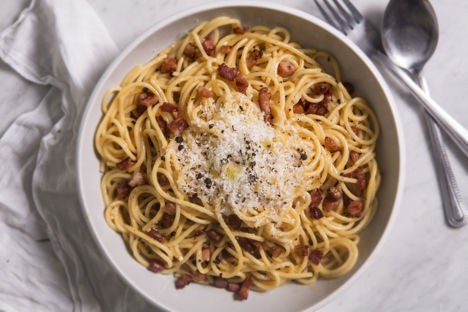
The origins of carbonara
Loved around the world, pasta alla carbonara is one of Italy's most famous (and debated) pasta dishes. We delve into the theories around how it came to be.
The origins of carbonara
Loved around the world, pasta alla carbonara is one of Italy's most famous (and debated) pasta dishes. We delve into the theories around how it came to be.
When it comes to pasta dishes, there are few quite as beloved as carbonara. One of Rome’s four classic pastas (alongside alla gricia, cacio e pepe and all’amatrciana), it’s a recipe not only cherished in Italy, but across the world – as well as being a staple on restaurant menus here, it has inspired everything from carbonara-flavoured ramen and pizza to seasonings and crisps. It can, of course, also lay claim to being one of Italy's most debated exports. Though some Italian recipes will go as far as specifying ingredients' origin before it can be considered truly traditional, in its most widely-accepted authentic form, carbonara is simple; a rich sauce made from eggs and pecorino, coating spaghetti and salty bites of guanciale, finished with black pepper. We, however, don’t need to tell you that plenty of cooks and chefs go off-script – whether it’s the addition of cream or butter, swapping out pecorino for Parmesan or using bacon lardons instead of guanciale, tweaks vary from country to country and home to home, much to the frustration of purists.
Though we might be able to agree on carbonara's popularity today, how it actually came to be is somewhat less settled. Its origins are, after all, as debated as its recipe, though the many theories largely fall into one of a handful of camps. One focuses on its name, which is said to have been taken from 'carbonaro', the Italian word for a charcoal burner, or 'carbone' (meaning, unsurprisingly, charcoal). That link has led some historians to surmise that the dish was initially cooked by the Italian 'carbonari' – charcoal workers – who would have prepared it over a fire while in the Apennine mountains, between Lazio and Abruzzo. Others say the name refers to the ground black pepper in the dish, which resembles coal dust (in some parts of America, this theory has given rise to the nickname of coal miners' spaghetti).
Others believe that it was inspired by the Neapolitan cacio e uova, a pasta dish which uses cheese and egg to create a similarly creamy sauce to that of carbonara. A recipe for that can be found in a cookbook written by Ippolito Cavalcanti in 1893, listing the ingredients as eggs, cheese and lard, and its existence has led to a school of thought that cacio e uova was the pre-Second World War name for carbonara.
That leads us onto one of the most popular theories for carbonara's origin – the war. Many believe the dish was created by American soldiers who were stationed in Italy and asked for 'spaghetti breakfast' using their rations of eggs and bacon with pasta. There are, after all, no mentions of pasta carbonara in written records before the war (it wasn’t included in Ada Boni’s 1930 La Cucina Romana book), but in 1950 an article in Italian daily newspaper La Stampa used the term to describe a dish that American soldiers had inspired when they adapted traditional recipes with eggs and bacon. That’s the belief of food historian Luca Cesari, who says carbonara was most likely born in Rome around that time, thanks to the presence of – and bacon brought over by – American soldiers. Indeed, one theory puts the creation of the dish down to a young Italian Army cook Renato Gualandi, who some believe first made carbonara in 1944, making use of the Americans’ bacon, cream, cheese and powdered egg yolks.
In 1952, author Patricia Bronté published a recipe for carbonara in Chicago, and two years later British food writer Elizabeth David included the recipe in her famous Italian Food cookbook in 1954. In the same year, the first Italian recipe appeared in magazine La Cucina Italiana (though at that point the ingredients included pancetta and Gruyère cheese), before, in 1960, a recipe in cookbook La Grande Cucina used guanciale and became the first to largely mirror what we know today. Carbonara soon travelled around the world, its popularity boosted here by the arrival of more Italian communities and increased travel abroad on holidays. Today, it’s a staple on pasta restaurant menus, and consistently ranks highly in surveys of our favourite pasta dishes (you can see our recipe for it here, a more Anglicised version here and our how to cook guide here).
However carbonara truly came to be, it seems most likely that it began life in the way that many dishes do – a combination of communities making use of what they had to hand and the influence of different cultures. Today, thanks to its quintessentially Roman ingredients, it is synonymously Italian, viewed as a symbol of Roman gastronomy, but its influence has travelled across the world and cemented carbonara's place as one of Italy’s most popular dishes.


